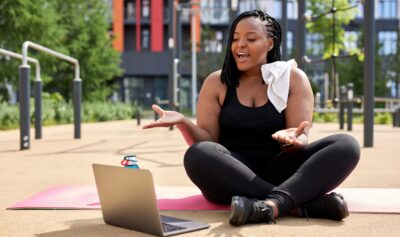While it’s crucial to develop a presence for your fitness business on social media, it’s an outlet that’s constantly changing. New features and algorithms influence user habits, and naturally, you’ll need to adapt the way you’re using different channels to keep up. A quick Google search for ‘social media trends 2020’ reveals insights that will likely mean a shift in your approach and the metrics that matter for your fitness business this year.
So whether it’s Facebook, Instagram, or an emerging new platform – we’ve curated the social media stats and trends that matter for fitness business marketing in 2020. Before we dive in, we’ll take a look at social media has changed in recent years. Skip ahead to:
- Social Media in Recent Years
- Social Media Usage in 2020
- 10 Key Stats on Social Media Advertising
- User Relationships With Brands on Social Media
- Social Media Marketing Trends 2020
Social Media in Recent Years
Many of the leading social networks have transformed since their beginnings, affecting both users and marketers alike. Small changes have had a big impact, and some trends have seemingly appeared from nowhere and taken over.
Consumers Become Brands
“Influencer marketing” is a term born out of social media and is now a common marketing strategy for thousands of brands. In a recent survey, 89% of marketers said that Instagram is the most important channel for this type of marketing. In the fitness industry, a host of fitness professionals have been able to leverage the influencer phenomenon to attract thousands of followers. It’s reshaped fitness marketing as we see these influencers go on to launch their own virtual workout guides, fitness apps and, ultimately, become a brand in their own right.
Instagram Stories Is Born
Instagram completely transformed the way its users interact with the platform following the launch of ‘Instagram Stories’ back in 2016. In just three years, the new feature acquired over 500 million daily users, and it’s now a key marketing asset for brands, marketers, and influencers.
Instagram story ads opened up a whole new way to engage with users. It’s success led to the latest feature addition to Instagram – IGTV. The popularity of these features highlights the growing importance of video content in social media.
TikTok Reshapes Social
New social platforms have also had their fair share of attention in recent years. Since launching in 2016, video-sharing social network TikTok is one of the fastest-growing social media platforms in the world. The platform is primarily fueled by Gen Z, with 41% of its users aged between 16 and 24 years old. With 500 million active users worldwide, the latest report from app intelligence company App Annie suggests that the platform continues to grow globally, ranking just behind Instagram based on its monthly active users. That’s pretty impressive growth for three years.
It’s clear that social media platforms are not what they used to be. With examples like TikTok redefining the social landscape, the networks we know and use will look very different in 2020, and we’re sure to see an even greater emphasis on video content.
Social Media Usage in 2020
Around 45% of the world’s population is now using social media, spending an average of 2 hours and 23 minutes a day on various channels. The average person has an account on more than nine different social media networks, and there are currently 3.5billion daily active social media users. A recent study from Emarketer shows that Millenials are investing the most.
Daily social media usage in three generations:
- Millenials – 90.4%
- Gen X – 77.5%
- Baby boomers – 48.2%
According to the study, Baby Boomers are becoming more astute with tech and branching out with social media platforms. Gen X is more likely using tablets, and Millennials are mostly using social on mobile. While Generation Z wasn’t included in the study’s comparison, they’re important demographic – especially in the fitness industry.
They may be off your radar now, but Gen Z is an up and coming market to the fitness industry and is projected to be 2.56 billion strong in 2020. 85% of this group learns about new products on social media, and they’re 59% more likely than older generations to connect with brands on social media.
Key takeaways:
- Get in front of your audience. If you currently target Millenials, you’ll most likely find them on Instagram. In 2020, for the first time, Instagram will have more users aged 18-24 than Facebook. It’s also the perfect platform for building your town gym community, which is a huge appeal for today’s Millenials when it comes to fitness.
- Tailor your content to specific platforms. While it’s no surprise that Millenials are the most prominent social users, there’s room to tap into different markets if you’re tactical about the kind of content you share on specific platforms. Baby Boomers are a totally different demographic, and you’ll find that 75% of them have an active Facebook account vs. the 21% that are on Instagram. Gen Z? Instagram is the most popular platform for its brand discovery.
10 Key Stats on Social Media Advertising
1. Social media ad spend in the U.S. will increase by 20.4% in 2020, putting figures up to $43 billion.
2. 37% of consumers find purchase inspiration through the content they see on social media.
3. 93% of social media advertisers use Facebook ads on a regular basis.
4. The potential reach with Instagram ads is 849.3M users.
5. Video content will make up a third of U.S. digital ad spend.
6. Facebook use among U.S. marketers is on a slight increase from 86.3% in 2018 to 86.8% in 2019. This number will likely reach 87.1% in 2020.
7. 42% of Millennials and 50% of Gen Z think social media is the most relevant channel for ads.
8. 71% of Gen Z said they’d like to see more diversity in advertising.
9. Mobile search ad spend will exceed desktop advertising spend in the U.S. for the first time by 2021.
10. Social media advertising click-through rate has dropped from 2.6% in Q2 2018 to 1.9% in Q2 2019.
User Relationships With Brands on Social Media
73% of Gen Z prefer brands to contact them about new products through Instagram.
54% of audiences use social media to research products and services.
The Top 10 Barriers
Slowing Your Fitness
Business Growth
Discover more 71% of people who have a positive experience with a brand on social media are likely to recommend them to friends and family.
49% of consumers claim that they depend on influencer recommendations
Social Media Marketing Trends 2020
Users Will Be ‘Digital Detoxing’
“People are growing weary of the constant stream of alerts on their phones and struggling to make it through a meal without checking their screens. They’re worried about being tracked. They have tech neck, and it hurts.”
Via nytimes.com
A new study reveals that out of 2,444 Americans, 64% scaled back their app use during a 14-month tracking period. The growing concern for social media’s impact on mental health has already prompted a shift for some apps and platforms.
- Apple introduced its ‘screen time’ feature in 2018 to address the hot topic of smartphone usage, addiction, and social media impacting health.
- In July 2019, Instagram introduced it’s ‘private like counts’ in 6 different countries. Mia Garlick, director of policy for Facebook in Australia and New Zealand, asserts the goal of this update was to “remove the pressure of how many likes a post will receive, so you can focus on sharing the things you love.”
What This Means For Your Fitness Business
This shift in consumer habits doesn’t need to be a cause for concern, as long as you adapt your strategy alongside it. There’s no need to share Instagram posts every day if your audience is consciously spending less time on social.
Last year, Lush UK chose to step away from its social media channels. The brand shifted its focus to join conversations that matter to its audience by using the hashtag #LushCommunity and closing its accounts on Facebook, Twitter, and Instagram.
In a transparent statement, Lush announced its decision on Instagram: “Increasingly, social media is making it harder and harder for us to talk to each other directly. We are tired of fighting with algorithms, and we do not want to pay to appear in your newsfeed.”
Nine months later and the #LushCommunity hashtag and its user-generated content live on. If digital detoxing is important to your members, you still need to stay relevant and maintain a sense of community. And this relies on understanding what your members want and what’s important to them.
Brands Will Invest in User-Generated Content
There’s already a significant emphasis on building a community when it comes to social media, and we know that community is a top motivator for people going to the gym.
User-generated content will continue to be a crucial aspect of this on social in 2020. It leads up to 90% of purchasing decisions, and 80% of businesses say that community building strategies have increased their traffic.
UGC is authentic, cost-effective, and easily shared – which is why we can expect to see more brands capitalizing on the trend this year.
What This Means For Your Fitness Business
It’s now more crucial than ever to focus your digital marketing efforts on building a community – and leveraging it. Whether you create Facebook groups to encourage like-minded people from your studio to get together, or you’re getting involved with relevant conversations on Twitter and Instagram. If you have an established community but need to encourage members to contribute more, incentivize them. Think about hosting special events or running a competition.
As with any marketing strategy, you need to start with setting objectives. What kind of content do you want from your users? How will you use it? There’s no point encouraging members to share extra content if you’re not going to use it effectively.
Whatever strategy you choose, make sure it’s gearing up to give you shareable results.
Influencer Marketing Will Become More Defined
Social media Influencers have played a key role in marketing trends, and while it’s an effective marketing tactic, there’s be skepticism in recent years. Stories of fake influencers buying followers and engagement hit the media in 2019 and made it difficult for both brands and consumers to know who to trust.
But, its far from the end for influencer marketing and 2020 will see a revolution in how brands work with influencers. As we’ve recently discussed – the fitness influencers of the future are building their brand on authenticity. With between 500 and 10,000 followers, micro and nano influencers will be the go-to for partnerships.
While the numbers are modest compared to some more prominent influencers, these accounts have built a genuine following of loyal users and are more likely to drive authentic engagement for brands.
What This Means For Your Fitness Business
If you’re new to influencer marketing, 2020 is the year to invest, because there’s now so much awareness around fake accounts.
When it comes to the fitness industry, there are literally thousands of fitness influencers on Instagram. Each one is usually well- known for something specific, like their objective or audience.
When it comes to whittling down your selection, make sure you’re thinking about your studio, brand, and target audience. How do your values align with the influencer? Will they resonate with your target market?
Speaking about building a network of local fitness influencers in this episode of The Fitness Founders Podcast, Stuart Brauer, founder of WTF Gym Talk has some insightful tips on keeping your influencer strategy close to home:
“Instead of one person with 100,000 followers, how about 50 of your clients that each have 1,000 followers. Who follows Sally, who’s been a member of your gym for two years? Sally’s friends, family, and co-workers. So why don’t you make your clients your influencer?”
In Summary
2020 is the year to choose your strategies and your platforms wisely. Community remains a crucial aspect of social media, but now more than ever, users want less noise and more relevant social media content.














